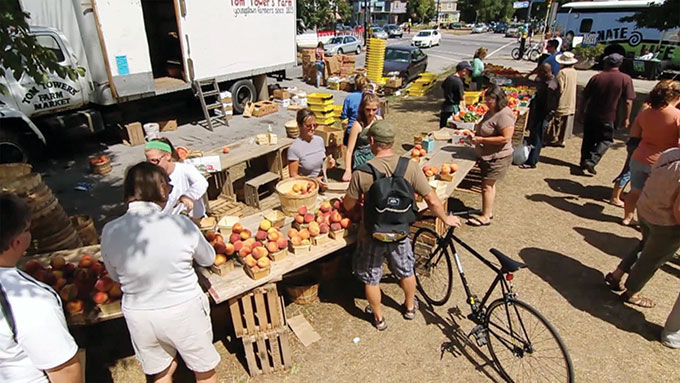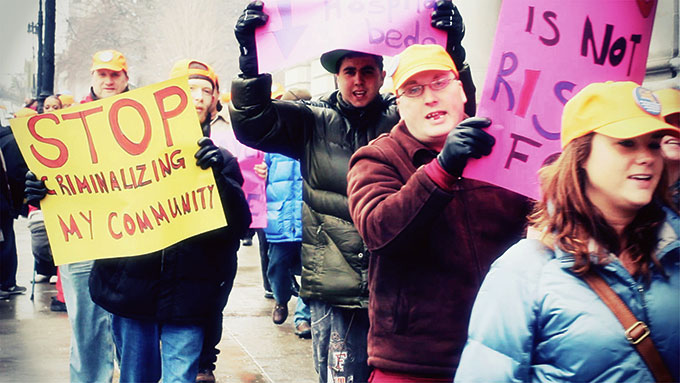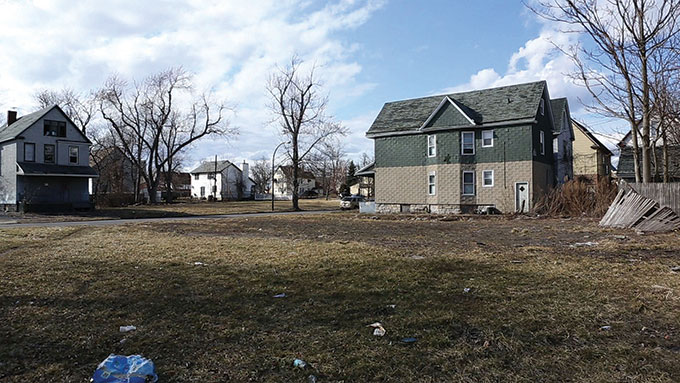What Happens Here
by Jack Foran

Three new documentaries in Squeaky Wheel’s Channels: Stories from the Niagara Frontier series
Three new videos in the Channels: Stories from the Niagara Frontier series will be premiered tonight (Thursday, April 18) at the Market Arcade Film & Arts Center, beginning at 7pm. The Channels series is an ongoing project of Squeaky Wheel that matches local videographers and community groups whose stories need telling.
The new videos are Rooted, by Kyle Toth and Ryan Delmar, in conjunction with the Buffalo First! organization, in its battle against globalization by promoting localism; This Doesn’t Happen Here, by Brian Milbrand, in conjunction with the Erie County Fair Housing Partnership, exploring Buffalo’s history of racial segregation and some of its challengers, including individuals and such activist organizations as Housing Opportunities Made Equal (HOME) and Neighborhood Legal Services (NLS); and Not Without Us, by Sam Avery, in conjunction with the Mental Health Peer Connection, a look at the struggle of recovering mental health patients in the face of general societal and legal institutional prejudices and discrimination in the attempt to get their lives in order and on an even keel;
These videos are intelligent, entertaining, compelling treatments of their various important topics.
•

“Does experience count as a form of knowledge?” That is the driving question of the Not Without Us video. What it comes down to in context is the question whether the mental patient’s own experience of his or her struggles—what the patient has learned from that experience about himself or herself, his or her special needs and abilities—should be a chief consideration in devising a treatment program for the patient.
Treatment and recovery program, that is. There seem to be two basic schools of thought about what’s best for mental health patients. A school focused mainly on medication. And a school focused on patient community self-help. The one seems to be more about maintenance. The other about recovery.
“My recovery didn’t start until I was in the hospital at ECMC and a peer came in and told me about their recovery,” one recovering or recovered patient testifies. Peer in this case meaning another person struggling or having struggled with mental health issues and working with the Mental Health Peer Connection (MHPC) organization, which is dedicated to the idea that there’s a better route to recovery than medication. In fact, medication—particularly given how widely it is resorted to as the main component in mental health treatment programs—can be a route in the other direction.
This video is about MHPC founder and director Maura Kelly’s vision that people diagnosed with mental health disorders “can and should go back to work.” And peer connection as the quickest and easiest way to make this happen.
And if it sounds like this is a debate between professionals in the field—doctors and doctorates in mental health areas—and non-professionals who suffer from mental health disorders, it’s not that simple. Spokespersons for the peer connection, anti-medication, side include articulate professionals and non-professionals alike.
Ultimately, it’s a video about self-determination (or not). Toward the end, there’s discussion of New York State and other state laws on the books or proposed that can force medication on a diagnosed mental health patient. One person called such laws “akin to a kind of rape.”
•
You’ll be less likely the next time to purchase through Amazon after hearing Jonathan Welch of Talking Leaves describe the local economic circulatory effect of buying at his and similar businesses. Four times the benefit to the local economy, as the money you spend locally gets spent again locally, and again, and again. This is the Roots video. Among other local entrepreneurs, Tim Herzog of Flying Bison Brewing Company, and Ethan Cox of Community Beer Works, and Tyra Johnson of Blue Sky Design, and Kevin Gardner of Five Points Bakery, and all the farmers at the Elmwood and Bidwell farmers’ market and the downtown farmers’ market.
You buy locally from them, and they buy locally, too. For practical business reasons, but also because as local businesspeople, they understand the local circulatory effect. One does well when everybody does well.
Kevin Gardner talks about buying wheat for his bread from local grain farmers. “It’s so easy,” he says. “You can work right with these people…There were fires in Russia, which drove the commodity price of wheat through the roof. It didn’t affect me at all…We just work with each other directly. It’s really nice.”
You’ll see your friends in this video, and maybe yourself. It was videographed all around the city, at the venues indicated above and more. Lots of people. Making lots of good economic choices.
•

The title This Doesn’t Happen Here is ironic, of course. Official segregation happened here starting with the city’s initial public housing project, Kenfield, in the late 1930s, which declared in its advertisements for applicants, whites-only. It happened when they finally created a single blacks-only housing project, Willert Park, in an area that previously had been racially mixed. Dante Place, later the Marine Drive Apartments, started out racially mixed, but then it was determined to move the blacks out, mostly to the ill-conceived gargantuan Talbert and Ellicott malls, again, basically all-black projects in what previously were racially mixed areas.
It happened through the collusion of banks (which redlined black neighborhoods, so that black people couldn’t get a mortgage or home improvement loan if they wanted one) and realtors (which steered whites to white areas, blacks to black areas, and made a killing with blockbusting techniques that terrorized white folk into selling out low, and enticing black folks to buy in high, in the end creating another segregated neighborhood that would then likely be redlined, fulfilling dire general expectations and reinforcing stereotypes and the utility of the terror tactic).
It got better, largely in conjunction with the enactment of federal fair housing laws, but as HUD Equal Opportunity Specialist Andrea Mujahid-Moore says eloquently in summing up: “It’s fairer, not fair yet…this country was founded on a segregated Constitution, and there are people who will always fight—and their seed will fight—to say that one race is better than another, one gender is better than another, one nationality is deserving of more than the other…”
|
Issue Navigation> Issue Index > v12n16 (Week of Thursday, April 18) > What Happens Here This Week's Issue • Artvoice Daily • Artvoice TV • Events Calendar • Classifieds |









 Current Issue
Current Issue